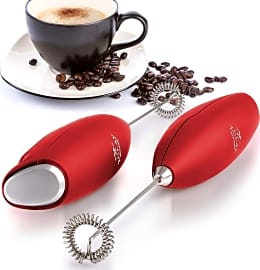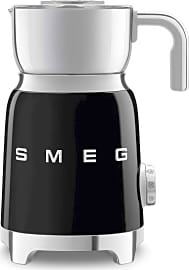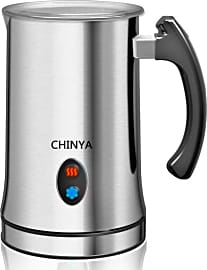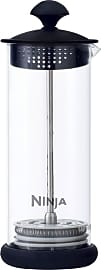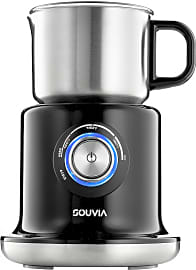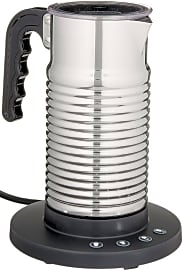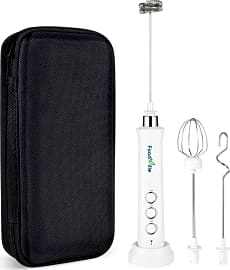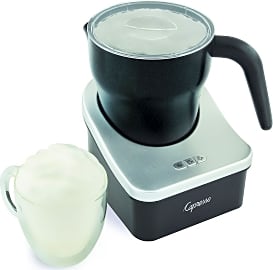The 10 Best Milk Frothers

This wiki has been updated 47 times since it was first published in February of 2015. Got a hankering for a latte, a cappuccino, or a hot chocolate? Engage your inner barista with one of these milk frothers which can help you prepare a deluxe hot drink in your own kitchen. We've included manually-operated models as well as automatic, electric steamers that take all the effort out of making your favorite creamy beverages, so you'll be sure to find one that suits your needs. When users buy our independently chosen editorial choices, we may earn commissions to help fund the Wiki.
Editor's Notes
November 20, 2020:
Despite sporadic reports claiming that the Breville Cafe is a fire hazard, we've still opted to include it as the top choice. The company has indicated that they have checked all such issues and the device poses no threat when used properly; to that end, be sure to read the instructions and operate it only as directed. But leaving aside this difficult-to-verify issue, the Breville machine has much to recommend it, from the tough stainless steel construction to the on-board disk storage. For something similar but less pricey, the Souvia Automatic makes a good alternative, although it beeps loudly, which can be quite annoying first thing in the morning.
If you're flush with cash and want a step-up option, look instead to the Smeg '50s Retro Style. It is just as handsome as it is functional, with a retro style that will blend perfectly into any kitchen with a 1950s decorative scheme, just as its name promises. Colors offered include a simple black, an eye-popping red, and several lovely pastels.
Finally, as for handheld options, we've kept the popular Zulay Milk Boss, which is currently available in an impressive range of colors. It doesn't arrive with batteries, but it runs on common AAs, and its design makes it easy to use in many travel mugs. We added the FoodVille MF09, as well, a travel-friendly option that has three whisks, a case, and a rechargeable battery. One drawback, however, is that it isn't quite as robust as some, so consider it best for occasional use, rather than as an everyday workhorse.
December 05, 2019:
Deluxe coffeeshop beverages are usually associated with rich, steamy milk, which sets them apart from a plain old cup of joe. Now you can create these fancy drinks right in your own home with a handy frother. You may own a fancy cappuccino maker that has its own built-in frother – but if not, one of these stand-alone models makes for a convenient, less expensive alternative.
The Zulay High Powered was added to the list today as a lightweight, portable choice that comes with a convenient stand and will fit nicely even on the smallest of countertops. We have personal experience with this one, and it’s a breeze to use and holds up well over time. All you need to do is hold down on the top button with your thumb and it froths your milk in seconds. Turning it to different angles as it works can help increase the volume of the milk. In all, it’s a convenient and affordable way to be able to add a finishing touch to your daily latte, cappuccino, hot chocolate, and more.
If you prefer a very different design that warms your beverage via induction heating, look to the newly added Breville Cafe, which features a sleek stainless steel jug and base. The jug is conveniently dishwasher friendly, and the base has a dial that allows you to control the milk’s temperature. It’s also great for making creamy hot chocolate when you add shavings or powder to the milk.
Leaving the selection today are the Eparé Whisk and the Kuissential Slickfroth 2.0, neither of which are available at this time.
Special Honors
Astra Pro Steamer Developed for the juice and smoothie bar industries, this steamer comes with a stainless steel wand that automatically controls its temperature, which is digitally displayed on the front panel. It features handy LED indicator lights and a smooth, shiny surface. It’s also equipped with a durable nickel-plated boiler and fittings, along with an automatic water fill with a vacuum valve to prevent milk from entering the boiler. astramfr.com
Why People Froth Milk
To create a macrofoam, the steam wand will be barely submerged under the surface of the milk.
People froth milk to make a variety of coffee, and in recent years, tea-based drinks. The most popular of these are the well-known lattes and cappuccinos. What the skilled barista knows that the average person does not, is that there are actually two different kinds of foamed milk: microfoam and macrofoam, each made with a specific use in mind.
Microfoam is made using the steam wand on an espresso machine and is best for use in lattes, where the barista will be creating latte art on the top. Latte art is made by preparing and pouring the foam in such a manner as to create a pattern or design in the surface of the latte. It can also be made by dragging a toothpick or other such utensil through the surface of the foam after pouring.
Macrofoam, sometimes called dry foam, has visibly larger bubbles than microfoam and a less creamy consistency. Its main use is in dry cappuccinos and macchiatos, where the foam should be sitting on top of the coffee, as opposed to a mixed together as in a latte or wet cappuccino.
When making microfoam, one will be steaming the milk. To make macrofoam for dry cappuccinos, one must froth the milk while heating it. Both of these foams can be achieved by using the steam wand of an espresso machine, but the technique is different. When steaming milk, the steam wand will be submerged more deeply. To create a macrofoam, the steam wand will be barely submerged under the surface of the milk. This aerates the milk more, giving it the airy consistency needed for dry cappuccinos. Macrofoam can also be created by using an electric frother or by heating the milk and using a frothing wand.
The Science Behind Milk Frothing
When milk is frothed, microbubbles are created inside of it. This is possible because of the proteins, such as casein and whey, which are found in milk. These protein molecules start out tightly bundled up, but when they are exposed to heat, they denature, allowing them to interact with each other.
Overly denatured foam milk will have large air bubbles that do not break down and mix with the drink.
Looking at it from a more scientific standpoint, we can see that the protein chains in milk are polar. One end of the protein chain is hydrophilic and the other is hydrophobic. The hydrophilic end is attracted to water, while the hydrophobic end is repelled by water. Milk, as with most other liquids, is in large part made up of water. When the protein chains are heated and unfold into the milk, the hydrophobic ends immediately try to get as far away from the water as possible.
If one were to look at a bubble of foamed milk in a microscope, they would see that all of the hydrophobic ends are pointed inwards, whereas the hydrophilic ends point outwards into the aqueous environment. This molecular structure is what allows the bubbles to become stable and stay intact in the milk long after the frothing process has finished.
The denaturing process is important to creating a consistent foam, but one does not want the milk to become too denatured as this will result in a milk foam that is too thick. Overly denatured foam milk will have large air bubbles that do not break down and mix with the drink.
Understanding The Most Popular Frothed Milk Drinks
The sheer number of options one is presented with when entering a coffee bar can be overwhelming. The first step to determining which type of frothed milk coffee drink is your favorite is understanding what each one is. This will make it easier to decide on which kind you want to try when searching out the perfect coffee.
First, in a latte macchiato the coffee is added to the milk, unlike a traditional latte where the milk is added to the coffee.
Most are familiar with cappuccinos and lattes, but even these common drinks come in multiple varieties. A cappuccino can be served either wet or dry. A wet cappuccino has more steamed milk than frothed milk, making it creamier, whereas a dry cappuccino has mostly frothed milk which sits on top of the coffee. Dry cappuccinos will typically stay warm longer as the foam acts as insulation and doesn't allow the heat to escape from the surface of the liquid.
A latte is made with espresso and steamed milk, usually in a 1:3 or 1:5 ratio. They will also have a small amount of frothed milk on top. In some regions of Europe, a latte may be referred to as a cafe au lait, although in America, a cafe au lait is usually just a coffee with scalded, unfoamed milk. Many often confuse latte macchiatos with standard lattes, but they differ in a few key ways. First, in a latte macchiato the coffee is added to the milk, unlike a traditional latte where the milk is added to the coffee. It also features a bigger head of foam and is often layered, instead of combined.
Macchiatos are comprised of one shot of espresso with a dash of foamed milk on top to cut some of the bitterness of the coffee. They resemble mini cappuccinos, but have a much higher ratio of coffee to milk. Macchiatos have a much stronger taste than cappuccinos. As with a latte macchiato, the milk is traditionally added to the cup first with the coffee being drawn through it, but not all baristas make it in this order. Macchiatos can also be ordered long or short. A long macchiato will have two shots of espresso with a small amount of hot water added. A short macchiato will have one shot of espresso with a smaller amount of hot water added.



